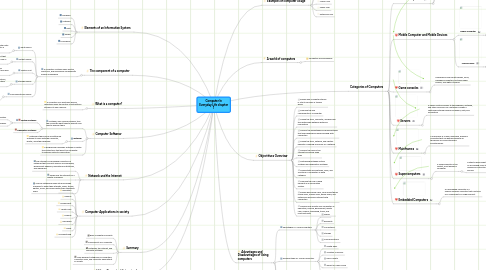
1. What is a computer?
1.1. A computer is an electronic device, operating under the control of instructions stored in its own memory
2. The component of a computer
2.1. A computer contains many electric, electronic, and mechanical components known as hardware
2.1.1. Input Device
2.1.1.1. Allows you to enter data and instructions into a computer
2.1.2. Output Device
2.1.2.1. Hardware component that conveys information to one or more people
2.1.3. System Unit
2.1.3.1. Case that contains the electronic components of the computer that are used to process data
2.1.4. Storage Device
2.1.4.1. Holds data, instructions, and information for future use
2.1.5. Communications Device
2.1.5.1. Enables a computer to send and receive data, instructions, and information to and from one or more computers or mobile devices
3. Network and the Internet
3.1. The Internet is a worldwide collection of networks that connects millions of businesses, government agencies, educational institutions, and individuals
3.2. People use the Internet for a variety of reasons
3.3. A social networking Web site encourages members to share their interests, ideas, stories, photos, music, and videos with other registered users
4. Computer Softwear
4.1. Software, also called a program, tells the computer what tasks to perform and how to perform them
4.1.1. System Software
4.1.1.1. Operating system
4.1.1.2. Utility program
4.1.2. Application Software
4.2. Installing
4.2.1. Installing is the process of setting up software to work with the computer, printer, and other hardware
4.3. A programmer develops software or writes the instructions that direct the computer to process data into information
5. Elements of an Information System
5.1. Hardware
5.2. Software
5.3. Data
5.4. People
5.5. Procedures
6. Computer Applications in society
6.1. Education
6.2. Finance
6.3. Government
6.4. Health Care
6.5. Science
6.6. Publishing
6.7. Travel
6.8. Manufacturing
7. Video : Computer History in a barn
7.1. DigiBarn computer museum
8. Summary
8.1. Basic computer concepts
8.2. Components of a computer
8.3. Networks, the Internet, and computer software
8.4. Many different categories of computers, computer users, and computer applications in society
9. Categories of Computers
9.1. Personal Computers
9.1.1. A personal computer can perform all of its input, processing, output, and storage activities by itself
9.1.2. Two popular architectures are the PC and the Apple
9.2. Mobile Computer and Mobile Devices
9.2.1. Mobile Computer
9.2.1.1. Personal computer you can carry from place to place
9.2.1.2. Examples include notebook computers, laptop computers, and Tablet PCs
9.2.2. Mobile Device
9.2.2.1. Computing device small enough to hold in your hand
9.2.2.2. Examples include smart phones, PDAs, handheld computers, portable media players, and digital cameras
9.3. Game consoles
9.3.1. Examples include smart phones, PDAs, handheld computers, portable media players, and digital cameras
9.4. Servers
9.4.1. A server controls access to the hardware, software, and other resources on a network Provides a centralized storage area for programs, data, and information
9.5. Mainframes
9.5.1. A mainframe is a large, expensive, powerful computer that can handle hundreds or thousands of connected users simultaneously
9.6. Supercomputers
9.6.1. A supercomputer is the fastest, most powerful computer
9.6.1.1. Fastest supercomputers are capable of processing more than one quadrillion instructions in a single second
9.7. Embedded Computers
9.7.1. An embedded computer is a special-purpose computer that functions as a component in a larger product
10. A world of computers
10.1. Computers are everywhere
11. Objecttives Overview
11.1. Explain why computer literacy is vital to success in today’s world
11.2. Describe the five components of a computer
11.3. Define the term, computer, and describe the relationship between data and information
11.4. Discuss the advantages and disadvantages that users experience when working with computers
11.5. Define the term, network, and identify benefits of sharing resources on a network
11.6. Discuss the uses of the Internet and World Wide Web
11.7. Distinguish between system software and application software
11.8. Differentiate among types, sizes, and functions of computers in each category
11.9. Describe the role of each element in an information system
11.10. Explain how home users, small office/home office users, mobile users, power users, and enterprise users each interact with computers
11.11. Discuss how society uses computers in education, finance, government, health care, science, publishing, travel, and manufacturing
12. Advantages and Disadvantages of Using computers
12.1. Advantages of Using Computers
12.1.1. Speed
12.1.2. Reliability
12.1.3. Consistency
12.1.4. Storage
12.1.5. Communications
12.2. Disadvantages of Using Computers
12.2.1. Health Risks
12.2.2. Violation of Privacy
12.2.3. Public Safety
12.2.4. Impact on Labor Force
12.2.5. Impact on Environment
